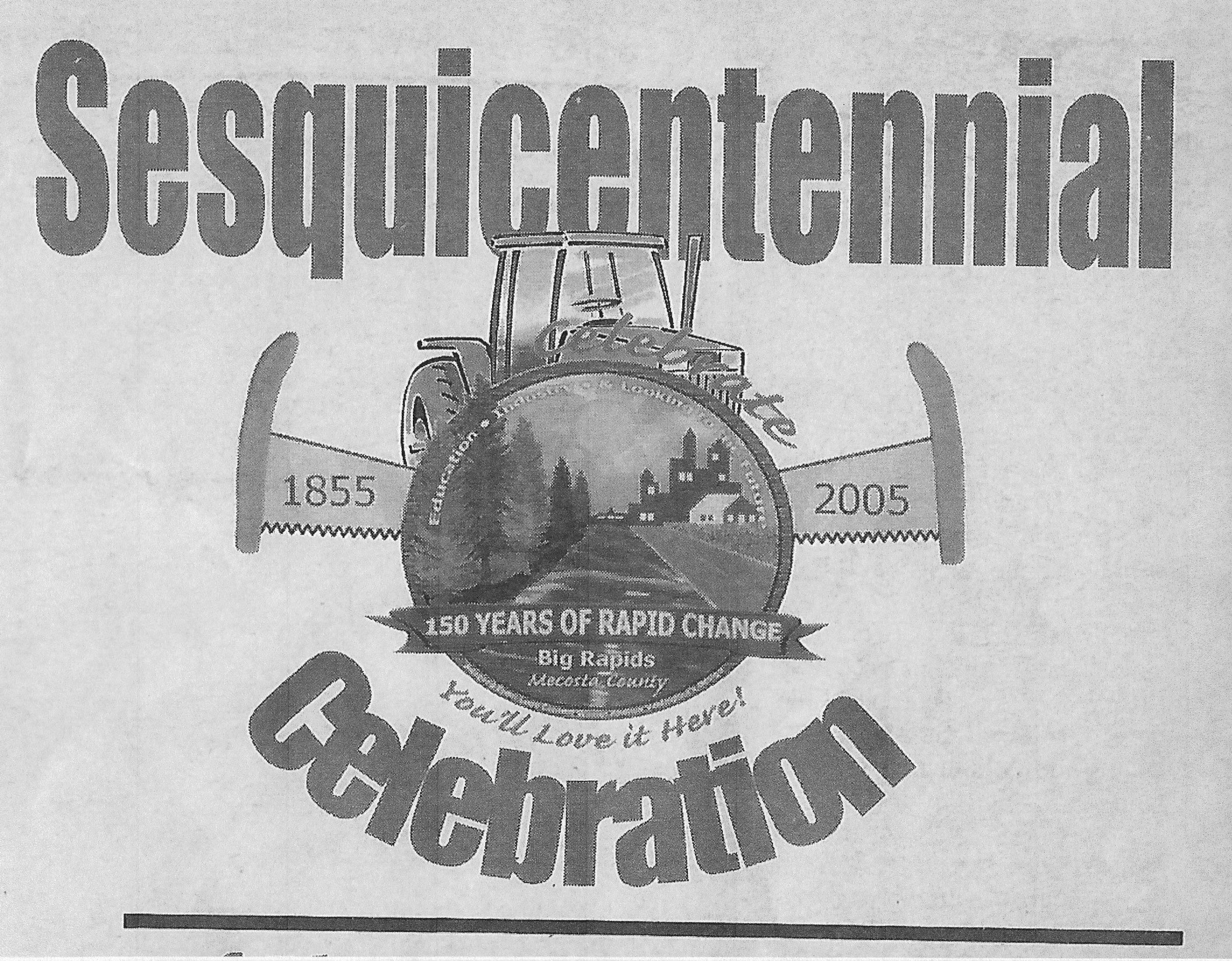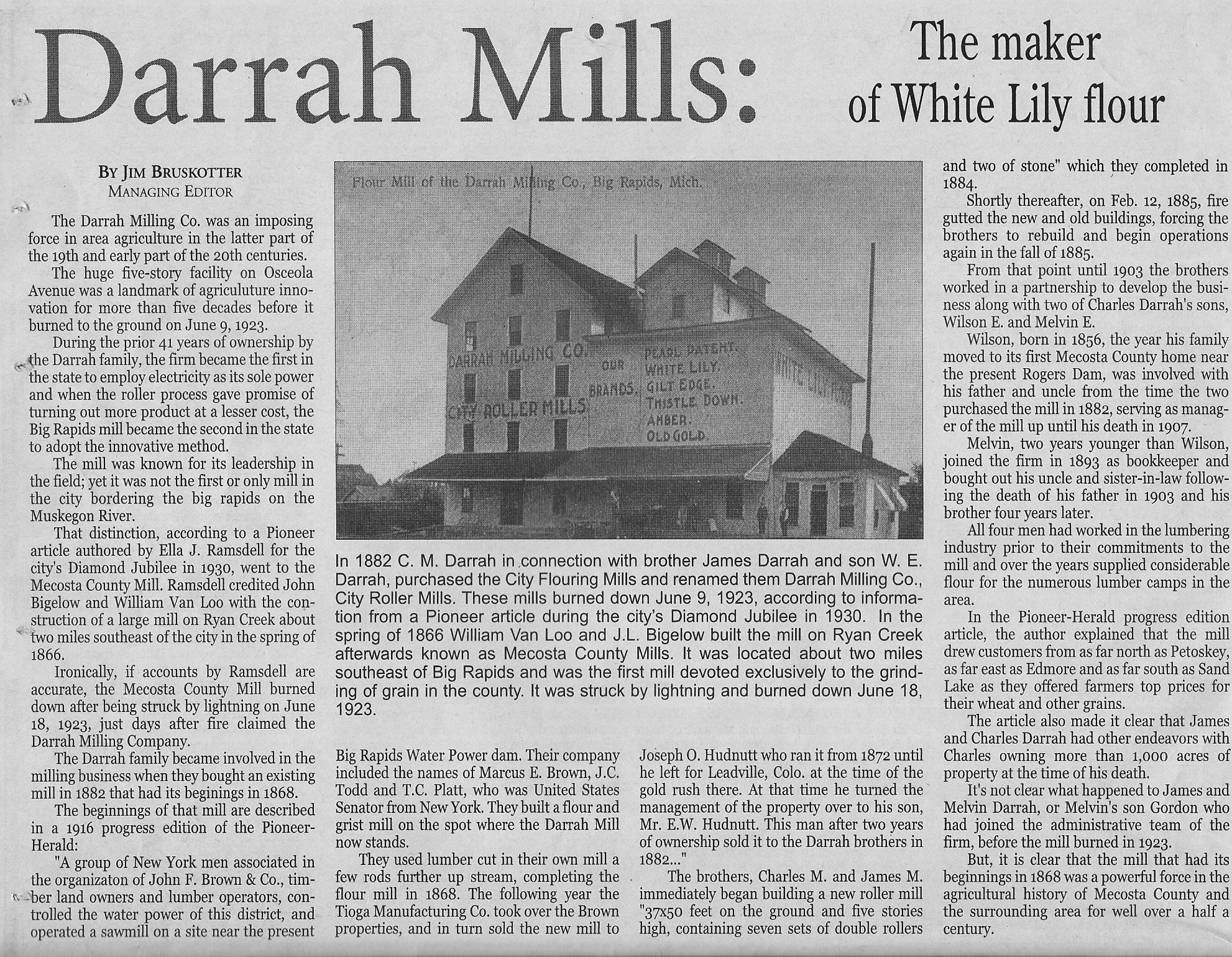
Part I - Agriculture, a supplement to the Big Rapids Pioneer Newspaper. Used with permission.

In 1882 C.M. Darrah in connection with brother James Darrah and son W.E. Darrah, purchased the City Flouring Mills and renamed them Darrah Milling Co., City Roller Mills. These mills burned down June 9, 1923 awccording toi information from a Pioneer article during the city's Diamond Jubilee in 1930. In the spring of 1866 William Van Loo and J.L. Bigelow built the mill on Ryan Creek afterwards known as Mecosta County Mills. It was located about two miles southeast of Big Rapids and was the first mill devoted exclusively to the grinding of grain in the county. It was struck by lightning and burned down on June 18, 1923.
DARRAH MILLS - THE MAKER OF WHITE LILY FLOUR
By Jim Bruskotter, Managing Editor
The Darrah Milling Company was an imposing force in area agriculture in the latter part of the 19th and early pat of the 20th century.
The huge five story facility on Osceola Avenue was a landmark of agriculture innovation for more than five decades before it burned to the ground on June 9, 1923.
During the prior 41 years of ownership by the Darrah family, the firm became the first in the state to employ electricity as its sole power and when the roller process gave promise of turning out more product at a lesser cost, the Big Rapids Mikk became the second in the state to adopt the innovative method.
The mill was known for its leadership in the field, yet it was not the first or only mill in the city bordering the big rapids on the Muskegon river.
That distinction, according to a Pioneer article by Ella J. Ramsdell for the city's Diamond Jubilee in 1930, went to the Mecosta County Mill. Ramsdell credited John Bigelow and William Van Loo with the construction of a large mill on Ryan Creek about two miles southeast of the city in the spring of 1866.
Ironically, if accounts by Ramsdell are accurate, the Mecosta County Mill burned after being struck by lightning on June 18, 1923, just days after the fire claimed the Darrah Milling Company.
The Darrah family became involved in the milling business when they bought an existing mill in 1882 that had its beginnings in 1868.
The beginnings of that mill are described in a 1916 program edition of the Pioneer-Herald.
A group of New York associated in the organization of John F. Brown & Co., timber land owners and lumber operators, controlled the water power of this district, and operated a sawmill on a site near the present Big Rapids Water Power Dam. Their company included the names of Marcus E. Brown, J.C. Todd and T. C. Platt, who was United States Senator from New York. They built a flour and grist mill on the spot where the Darrah Mill now stands.
They used lumber cut in their own mill a few rods further up stream completeling the flour mill in 1868. The following year the Tioga Manufacturing Co. took over the Brown properties and in turn sold the new mill to Joseph O. Hudnutt, who ran it from 1872 until he left for Leadville, Colo, at the time of the gold rush there. At that timehe turned the management of the property over to his son, Mr. E.W. Hudnutt. This man after two years of ownership sold it to the Darrah brothers in 1882.
The brothers, Charles M. and James M. immediately began building a new roller mill "37 x 50 feet on the drounf and five stories high, containing seven sets of double rollers and two of stone" which they completed in 1884.
Shortly therafter, on Feb 12, 1885. fire gutted the new and old buildings, forcing the brothers to rebuild and begin operations again in the fall of 1885.
From that point until 1903 the brothers worked in a partnership to develop the business along with two of Charles Darrah's sons, Wilson E. and Melvin E.
Wilson, born in 1856, the year his family moved to its first Mecosta County house near the present Rogers Dam, was involved with his father and uncle from the time the two purchaed the mill in 1882, serving as manager of the mill up into his death in 1907.
Melvin, two years younger than Wilson, joined the firm in 1893 as bookkeeper and bought out his uncle and sister-in-law following the death of his father in 1903 and his brother four years later.
All four men had worked in the lumbering industry prior t their commitments to the mill and over the years supplied considerable flour for the numerous lumber camps in the area.
In the Pioneer-Herald progress edition article, the author explained that the mill drew customers from as far north as Petpsky, as far east as Edmore and as far south as Sand Lake as they offered farmers top prices for their wheat and other grains.
The article also made it clear that James and Charles Darrah had other endeavors with Charles owning more than 1,000 acres of property at the time of his death.
It's clear what happened to James and Melvin Darrah, or Melvin's son Gordon who had joined the administration team of the firm, before the mill burned in 1923.
But, it is clear that the mill that hat its beginnings in 1868 was a powerful forcein the agricultural history of Mecosta County and the surrounding area for well over a half a century.
Return to Home Page


